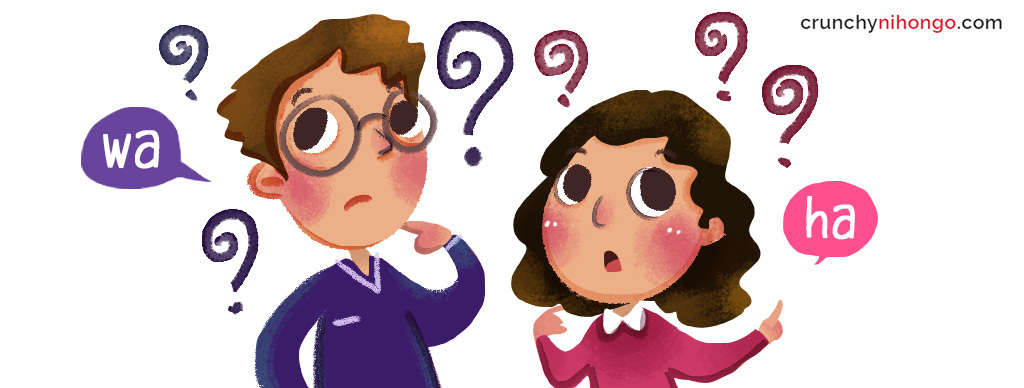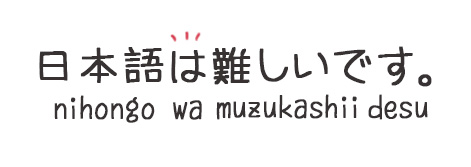Hi ! We hope this site helps you! ٩(ˊᗜˋ*)و As an Amazon Associate, we earn from qualifying purchases without additional cost. Click to read more about our Privacy Policy or Affiliate Disclosure
There are quite a lot of confusions as to why some books/article read は as ha or sometimes as wa. And here’s the answer to the questions.
…………………………………………
WA VS HA

Actually to determine whether to read it as wa or ha, first you need to know why it is read as WA in the first place.
Hiragana は is indeed being read as ha. But this hiragana は also have a specific purpose in Japanese language, which is as a particle to mark a topic marker. Complete explanations about this particle wa usage can be seen here Particle は, the topic marker.
When being used as a particle, you read it differently. You read it as WA.
If you’re confuse, think about it like this. Your best friend John is also your boss. When in private situations, you would call him as John. But in the office, you would address him as Boss!
Although most of people understand the concept above, what confuse them is to know when to read it as wa or ha. Below we will learn a bit tricks to differentiate when to read it as wa or ha.
Important If you are going to type は in a computer/smartphone/etc using standard ABC keyboard, you can only type it by writing HA. Writing WA will give you わ instead.
…………………………………………
WA or HA
Although there is no concrete formula to determine it. Here’s some tips which might help you to differentiate them.

IF IT IS A PART OF A WORD/VOCABULARY, it will read as HA.
If it’s written after a word/sentence and it looks like it’s not a part of a word, it usually a particle and read as WA.
In above case, WATASHI is a common known word means I. while HARUKA seems like a name. As a name, it will NEVER be read as WARUKA. If the name is WARUKA, it will be written with ordinary わ.
は writen after a known word such as WATASHI usually must be a particle and thus must be read as WA. Furthermore, to connect WATASHI and HARUKA will require particle, so it’s obvious that the は is a particle and thus read as WA. I hope this make sense!
In a heavily kanji text, you can differentiate it easily since most of the word will be written as kanji, therefore the remaining は must be a particle and read as WA.
 …………………………………………
…………………………………………
BASIC CONCLUSION
As you can see, to differentiate WA or HA, will require you to have knowledge of Japanese vocabulary/words. If you know what the words is, it will be easy to distinguish the は which is being used as particle. The problem arises when you don’t know what the word is. In this case use a dictionary to help you determine the words
Don’t worry if you still have a hard time to differentiate them now though, as time goes by, read a lot Japanese sentence, and the pattern will automatically be recognized in your brain!
…………………………………………
ADDITIONAL: COMMON CONFUSING CASES OF WA or HA
Below is some common case in which basic Japanese learners might stumble upon and get confuse as to why it is read as WA while it doesn’t seem like a topic marker particle they know about.
…………………………………………
CASES 1: こんにちは (KONNICHIWA)

This Japanese greeting is quite famous. Even people who doesn’t learn about Japanese might know this phrase. KONNICHIWA means “Good day!/Hello!” and used in the morning, while KONBANWA is another version which is used in the evening and means “Good night!”.
Most people are confused as to why these greetings use hiragana は but read as WA since they looks like a part of the words and not a particle. As results, there are some people who read/type it as KONNICHIHA instead KONNICHIWA and KONBANHA instead of KONBANWA.
So let’s solve this case here. KONNICHIWA / KONNICHIHA?
First… YES, they are written with hiragana は. こんばんは and こんにちは.
And YES, they are read as WA not HA. So it’s KONNICHIWA and KONBANWA.
Why they are being read as WA?
To understand why they are being read as WA not HA, you need to know that they are greetings. They are not exactly a noun/vocabulary.
They are actually an abbreviation (a lazy version) of a long sentence. “Konnichi wa gokiken ikaga desu ka?” which means “How are you feeling today?”. so the KON NICCHI means “This day” while the は is actually being used as particle in that sentence. In the case of KONBANWA, KON BAN meaning “This night/evening”.
Long story short, time passes and the polite long sentence is being abbreviated into just KON NICHI WA and KON BAN WA. That is the answer as to why they are read as WA. Hope it helps!
Related • Japanese Particle: Topic Marker Particle は
…………………………………………
CASE 2: は in ではありません and ではないです
DE WA ARIMASEN and DE WA NAI DESU should be familiar to basic learners since it’s being taught in almost every basic lessons. It’s used as a negative versions for NOUNS and adjective-na.
Useful notes Do you know that Adjective-na is basically a noun ?
So what happened here ?

Let use DE WA ARIMASEN for the sample. You should be familiar with DESU or DA (less formal & more manly), a word we use to end a sentence. Such as BUNNY desu or BUNNY da.
The WA is a topic marker particle that help to NEGATE the DESU/DA.
If you are confuse, it’s safe to just memorize this: Whenever you want to use DEWA ARIMASEN / DEWA NAI DESU , you need to use は.
…………………………………………
CASE 3: PARTICLE は COMBINED WITH OTHER PARTICLE
This is a more advance topic. But incase that you happen to stumble upon them…
Particle は can follow some other particle such as に, と and で.
And thus become には “ni wa”, とは “to wa”, では “de wa”. Note that not all particles can be combine with be followed with は though.

The usage of these combined particles is vary. For example let’s use NI WA. One of it’s usage is when you want to use IRU / ARU to mean POSSESION of something. For example, you want to say “He has a dog”. It will be “KARE NI WA INU GA ARIMASU”. This is not mandatory though. Just “KARE WA INU GA ARIMASU” will also work as well…
There are a lot more to say about the meaning of those combined particles, but they are quite advance topic and might confuse basic learners. For now, just remember the fact that particle は can be combined with some other particles.
…………………………………………
We hope that this page helps you to understand why some は is read as WA and also to help differentiate the usage. Stay tuned for post about commonly asked questions regarding Japanese language!
Happy learning!
。゚✶ฺ.ヽ(*´∀`*)ノ.✶゚ฺ。
